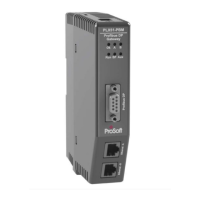PLX51-PBM Operation
PROFIBUS DPV0/DPV1 Master or Slave to EtherNet/IP™ or Modbus® Gateway User Manual
ProSoft Technology, Inc. Page 110 of 196
DPV1 Class 2 Messaging (MS2)
DPV1 Class 2 messaging is possible from several DP masters simultaneously, but
the connection must be established explicitly by each DP Master. Below are the
EtherNet/IP CIP message parameters as well as the request and response data
structures.
DPV1 Initialize (Establish Connection)
CIP Message:
Table 5.11 – DPV1 Class 2 Initialize Message
20 +
(2 + Source Net Address Length + Source MAC Address Length) +
(2 + Destination Net Address Length + Destination MAC Address Length)
Request Data:
Table 5.12 – DPV1 Class 2 Initialize Request
The amount of time (in milliseconds) the PLX51-PBM waits for
a DPV1 response before timing out and responding to the
EtherNet/IP request with a Timeout Status.
The station number of the PROFIBUS device.
The total time of the Class 2 connection. Time is based off
10ms.
The services supported by the PLX51-PBM.
Octet 1:
Bit 0: This bit is set if the DPV1 Class 2 Read/Write services
are supported by the PLX51-PBM.
Bit 1-7: Reserved.
Octet 2: Reserved.
Profile Features
Supported
The profile specific services supported by the PLX51-PBM.
The meaning of the bits are vendor/profile specific.
This parameter defines a unique profile definition, independent
from the Identity Number. If the requested profile is supported
by the slave, it will be mirrored in the response.
This indicates the use of an optional Network/MAC address
(Source Type = 1) in the address information of the source.
The total length of the address information of the source. The
source address includes the: Source API, Source SCL, and an
optional Source Network/MAC Address.
This indicates the use of an optional Network/MAC address
(Destination Type = 1) in the address information of the
destination.
Destination Address
Length
The total length of the address information of the destination.
The destination address includes the: Destination API,
Destination SCL, and an optional Destination Network/MAC
Address.
The application process instance of the source.
The access level of the source (0 = no access level used).

